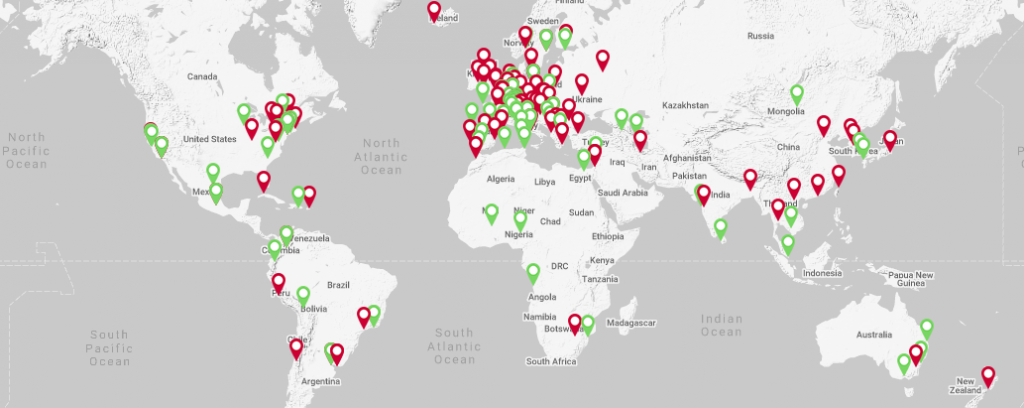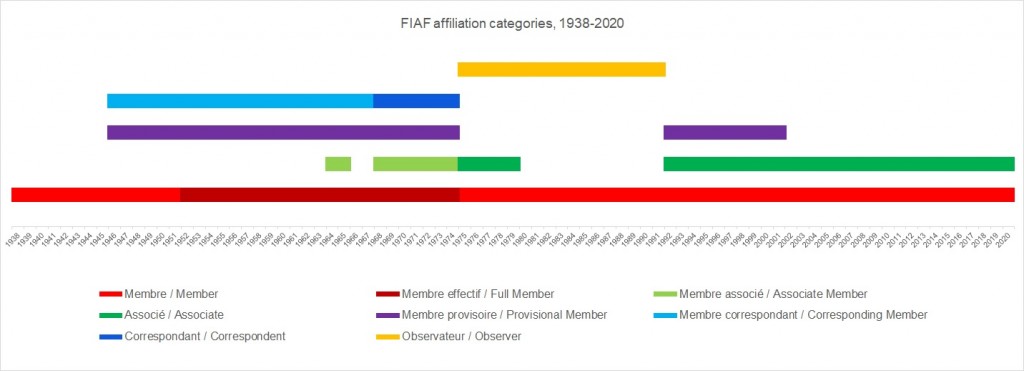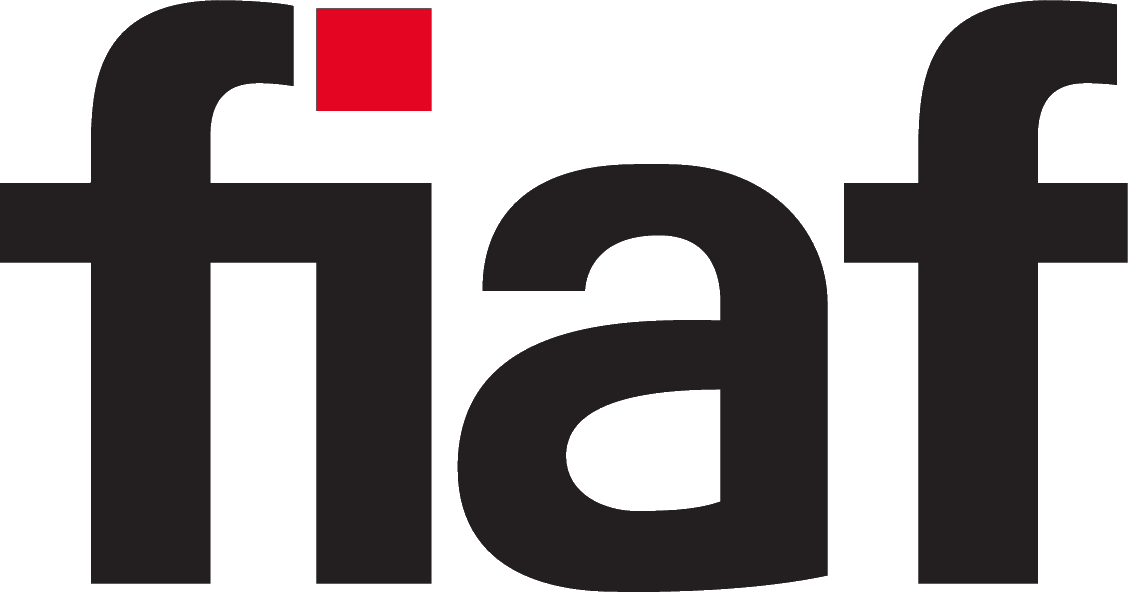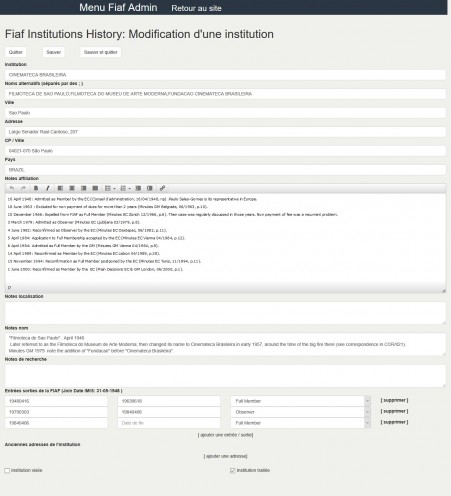
FIAF Affiliation History Database: Explanatory Note about the Project
Origins and Evolution of the Project
The origin of the project goes back to 2013, when it was first suggested to FIAF Senior Administrator Christophe Dupin that a world map showing all current FIAF affiliates could be a worthy new resource for the FIAF website. Various test versions were conceived at the time, but none was considered satisfactory enough to be published. Fast-forward to 2018. Partly inspired by the chrono-geographical app “Cine-Grenoble” developed by the Cinémathèque de Grenoble (see Journal of Film Preservation, Issue 99, October 2018, pp. 119-125), Christophe Dupin and FIAF web programmer Jean-Pascal Cauchon attempted to add a historical dimension to the original map, by conceiving a new dynamic map showing the geographical expansion of the FIAF network since 1938. A first version of that map was completed, but the simple database on which it was based was problematic for several reasons:
- It only included institutions currently affiliated to FIAF. It did not include either the many institutions which once were, but are no longer, FIAF affiliates (we have since identified almost 50 of them).
- It only took into account the date at which current FIAF affiliates had first joined FIAF, and it turned out that that joining date (which is documented in the FIAF contacts database, and the origin of which is unknown) was not always correct or precise enough.
- The database did not include FIAF affiliates’ various changes of affiliation category over time, or periods in which they were no longer affiliated to FIAF.
So we realized that in order to create a map showing the exact and precise geographical evolution of the FIAF network since 1938, including all changes of affiliation categories, a lot more research would be needed. Around that time, French film historian Stéphanie E. Louis showed great interest in the database and decided to join the project. Not only did she bring methodological rigour to the database, but from August 2018 she also carried out the bulk of the research herself during a number of visits to the FIAF office, entering the data into the system and correcting it when needed. By early 2020, this work had been completed and the data fully checked, and the database search engine and associated chronological world map of FIAF affiliation history was ready to be launched on the FIAF website. We were hoping to introduce this new resource to the FIAF community during the FIAF Congress in Mexico City, but the coronavirus pandemic decided otherwise.
Documentary Sources and Methodology
Our research was based on several sets of documents preserved in the FIAF Historical Archive at the FIAF Secretariat in Brussels. Official minutes of FIAF’s annual General Assemblies (previously known as General Meetings) and reports of FIAF Executive Committee meetings were all systematically and thoroughly consulted, and constituted the main source of information about institutions joining FIAF, leaving FIAF, or being expelled from it, or changing affiliation category. FIAF membership lists (and later FIAF Directories) published over the years, as well as individual affiliation files of past and present affiliates and files of correspondence between FIAF and FIAF affiliates, were also occasionally consulted to shed light on situations that official meeting reports had failed to clarify.
Our main research objective was closely linked to the chronological map we wanted to publish. For this map to be absolutely correct, we had to identify and document the exact dates of each FIAF affiliate’s admission to and departure from FIAF, as well as the exact dates of each of their changes of affiliation category. As mentioned earlier, we started by analysing the minutes of every General Assembly and the report of every Executive Committee meeting in chronological order. We soon realized that while some FIAF affiliates have had a rather uneventful and straightforward affiliation history (for instance, The Museum of Modern Art Film Department and the BFI National Film Archive, both of which have been Members of FIAF since 1938), others followed a much more tortuous affiliation path, with several changes of affiliation categories, and departures from, and readmissions to, FIAF. Such changes were dependent on the individual circumstances of each institution, but also changes in the Federation’s official affiliation categories over time. Indeed, if the FIAF community currently consists of Members and Associates, it was not always the case. At specific times in FIAF’s history and for a number of reasons, the FIAF Executive Committee and the General Assembly decided to restructure the different categories of affiliation to the Federation by redefining existing categories, introducing new categories, or removing others. Broadly speaking, three categories emerged in the post-war period – first, (Full) Members, and soon afterwards Provisional Members and Corresponding Members, with the Associate Member category introduced for a while in the 1960s. Significant reforms of the affiliation structure then took place in 1974 (Full Members, Observers, and Associates), 1979 (Full Members and Observers), 1991 (Full Members, Provisional Members, and Associates), and 2001 (Full Members, Associate Members). Note also that the official terminology of each of these categories has evolved over the years (for instance, “Full Members” from the early 1950s to 1974, and “Members” since then; “Associate Members” from 1964 to 1966 and 1968 to 1979, and “Associates” since 1991; “Corresponding Members” from the late 1940s to 1968, then “Correspondents” to 1974). That is not even taking into consideration the French equivalent terminology (French being the other official language of FIAF since 1938). For clarity’s sake, we decided to use the same category wording throughout FIAF’s history in the various database fields and in the map legend, i.e., Full Member, Associate Member, Corresponding Member, and Observer. See the graph below for the evolution of the affiliation categories throughout FIAF's history.

We also strongly felt it was essential to cite the sources from which the affiliation information was drawn, in order to provide a reliable and serious database for future research. These documentary references were systematically added to the “Affiliation notes”, “Name notes”, and “Address notes” fields. For all General Assembly and Executive Committee reports, we noted the name of the meeting at which the affiliation decision had taken place, the month and year and city of the meeting, and the exact page number. As the names of those meetings (for instance, “General Meeting” until 1997, and “General Assembly” since then) and the titles of their reports (for instance, “Minutes” or “Main Decisions”) have changed over the years, we decided to respect those historical names and titles in our notes. However, in order not to burden our notes fields with too much information, we used short versions of those names (for instance, “Minutes GM Moscow, 06/1964, p.20”, or “Minutes EC Toulouse, 01/1984, p.8”). Note that most of these General Assembly Minutes or Executive Committee meeting reports have been digitized and are available to all in the history section of the FIAF website, while the most recent of those reports are available online to members of the FIAF community only.
Current limitations of the database and map
Although we have made every effort to document the affiliation history events (admission, change of category, expulsion, or resignation) of each past and present FIAF affiliate as precisely and correctly as possible, thanks to the systematic and thorough consultation of the various archival documents mentioned earlier, several significant limits must be noted.
- Although every effort was made to find the exact dates of affiliation, some of these events were unfortunately not recorded (or not recorded clearly) in official reports and other documents available. In those few cases, we had to estimate the formal date of that event as precisely as the documentation available allowed us. Some of these date choices were made arbitrarily, but such cases are clearly indicated in the various notes fields.
- As most General Assembly and Executive Committee meetings last several days, and it was not always clear when exactly affiliation issues were discussed, we decided that when unknown, the date of the affiliation decision would be the first day of that meeting (as affiliation issues have often been discussed at the start of GAs and EC meetings).
- The name of each FIAF affiliate appearing on the map at any point in FIAF’s history is the current (or last known) name of that institution, and not the name of the institution at those different times. We did try to document the previous or alternative names that we came across during our research as much as possible – these appear in the fields “Alternative or former names” and “Name notes”. However, this was not done on a fully systematic basis, and these alternative names are not taken into account in the chronological map, as it would have meant finding the exact dates of each of those name changes, which would require considerably more research.
- For similar reasons, the address of each institution (and therefore its exact location on the affiliation map) is in most cases its current or last known address. Documenting previous addresses precisely is technically possible in the database (and the fields are available), but it would also imply a lot more research than we had time for at this point, as we would need to find the exact in and out dates for each separate address. So far, we have only managed to do this for a handful of historical affiliates for which we have a lot of precise information (the BFI National Archive, for instance). This aspect of the database can be documented progressively in the future, hopefully with the help of FIAF affiliates.
Some technical considerations
The conception of the map and of the database owe a great deal to FIAF’s web programmer Jean-Pascal Cauchon, who developed a database management system as part of the FIAF website’s back office, which he built especially for us. The project was developed in a classical Web environment: PHP / JavaScript / MySQL. The name, address, and affiliation data collected for each past and present FIAF affiliate has been entered in a form created by Jean-Pascal, accessible from a list of all affiliates (see the screenshot below). Basic name and address data for all current FIAF affiliates was imported from FIAF’s in-house contacts database, to save time, and further information was then added to these existing records. The records of all institutions no longer affiliated to FIAF were created from scratch.
The link between the database and the map operates as follows. When the address of each institution (present or past) is entered in the database, a call is made to the Google Maps API [Application Programming Interface] to retrieve the GPS coordinates of the address (which are also stored in base to limit the number of calls to the API).
The display is done on a custom Google Maps map (always via the Google Maps API). The geographical coordinates and affiliation category of the affiliates are retrieved in JSON format in the database when the map is loaded.
A JavaScript development allows the user to see the evolution of the affiliation status of all affiliates over time when he/she moves the year cursor sideways in the legend of the map. The affiliation information for each institution displayed on the map is retrieved from the database asynchronously by an Ajax call (one call per record).
The future… and the wider picture
Like so many projects in FIAF’s history, this database is meant as a collective endeavour, which can be improved and further developed by your contribution. If you notice an error in the data entered to date, or wish to clarify certain ambiguities or provide missing information (for instance, regarding successive names or addresses of FIAF affiliates), please don’t hesitate to contact us at info@fiafnet.org. Please provide precise information about your sources, and ideally a copy of the documents supporting your facts, so that the database continues to be scientifically documented.
In 2019, FIAF initiated a new FIAF History Project with the financial help of the Jan de Vaal Fund (created by Tineke de Vaal, widow of the former Director of the Nederlands Filmmuseum Jan de Vaal), the aim of which is to research the history of FIAF and the film archive movement, and publish a number of new resources on that topic. These will include a book on the first 50 years of FIAF and a comprehensive multi-thematic and interactive FIAF timeline. We see this FIAF affiliation history database as one of the early outcomes of this Project.
Authors
Stephanie E. Louis is Coordinator of Research Activities at the École nationale des chartes, a member of the Centre Jean-Mabillon, and Associate Researcher at the Institut d'histoire du temps présent (Paris). She works on the history of film heritage practices, and recently published La Cinémathèque-Musée, une innovation cinéphile au cœur de la patrimonialisation du cinéma en France (1944-1968) (Paris: AFRHC, 2020).
Christophe Dupin is the Senior Administrator of (FIAF), and a film historian. Previously, he carried out extensive doctoral and post-doctoral research on the history of the BFI, which resulted in the publication of The British Film Institute, the Government and Film Culture, 1933-2004 (Manchester University Press, 2012), co-edited with Geoffrey Nowell-Smith. His current research topic is the history of FIAF.
Jean-Pascal Cauchon is an independent web programmer, and the creator of the current FIAF website (2013), which he has since continued to develop. Based in Tours (France), he was trained as an IT specialist, and first worked as IT manager for several companies before his career took a different direction in 2006, when he decided to become a primary school teacher, until he set up his own web programming business in 2011.






